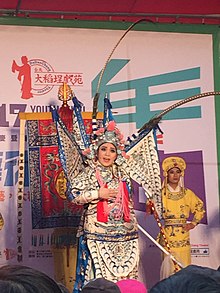Xiaosheng

Thexiaosheng(Chinese:Tiểu sinh;pinyin:xiǎoshēng;lit.'little (gentle)man') is a male role type inChinese operaand a subtype of thesheng.Mostxiaoshengcharacters are youngConfucianscholars or, less often, young warriors.
Unlikelaoshengactors,xiaoshengactors do not wear a beard. However, not all beardless roles are necessarilyxiaosheng,for example eunuchs (huanguan) can be played byxiaosheng,chou,jing,orlongtaoactors (extras).
Subtypes
[edit]Confucian scholars and officials
[edit]Thejinshengorjinzisheng(Cân sinhorCân tử sinh,"clothsheng"), sometimes also known as theshanzisheng(Phiến tử sinh,"fansheng"), is a young Confucian scholar who has yet to pass theimperial examination.He wears therujin( "Confucian cloth" ) on his head and often holds ahand fan.This role is often featured in romantic dramas and requires the ability to play with the fan to exude an air of elegance and class.[1]
A slightly different version is theqiongsheng(Cùng sinh,"poorsheng"), also known askusheng(Khổ sinh,"sufferingsheng") orxiepisheng(Hài bì sinh,"shoe-skinsheng"), the impoverished young scholar.[2]Although optimistic for the future, he is dejected and frustrated, and drags his feet in half-on shoes when he walks. Inkunqu,he sings and talks with a "sad sound" and does not dance.[1]
Theshamaosheng(Sa mạo sinh,"gauze-capsheng"), known asxiaoguansheng(Tiểu quan sinh,"young-officialsheng"orTiểu quan sinh,"small-crownsheng") or simplyguansheng(Quan sinh,"officialsheng") inkunqu,[1][3]is a young scholar who recently passed theimperial examinationand became ascholar-official.He wears thefutouand a belt which could only be worn by government officials.

Warriors
[edit]Beardless warriors who only "fight" on stage are consideredwushengrather thanxiaosheng.However, the young warrior who sings is known as thewuxiaosheng(Võ tiểu sinh,"martialxiaosheng"). Awuxiaoshengwith some stature[4]wears a cap with two long pheasant tail feathers attached and is known as thezhiweishengorlingzisheng(Trĩ vĩ sinhorLinh tử sinh,"pheasant-tailsheng"); this is usually a young general or a general's young son.[1]Azhiweishengactor must be skilled at handling the feathers with their hands to express emotions.[5]
InCantonese opera,the leading male role is usually thewenwusheng(Chinese:Văn võ sinh;Jyutping:man-mou-saang,Hakka:vun-vu-sang,"civilwusheng") which combined thexiaoshengand thewushenginto one role. (On the other hand, the juniorwenwushengor the secondary male role is known as thexiaoshengorsiu-saang.[6]) This role type is also present inHakka opera.
Others
[edit]Jia Baoyu(an aristocrat),Tang Sanzang(Buddhist monk),Xu Xian(physician),Jiang Yuhan(actor) andHan Xiangzi(mythological figure) are examples of otherxiaoshengcharacters.
Vocal techniques
[edit]InPeking opera,thexiaosheng's singing style is a mix betweenfalsettoand chest voice and is therefore known as the "yin-yang voice" (Âm dương tảng tử).[7]
References
[edit]- Dolby, William (1976).A History of Chinese Drama.Elek Books.ISBN0-06-491736-3.
- Ye, Tan (2008).Historical Dictionary of Chinese Theater.The Scarecrow Press.ISBN978-0-8108-5514-4.
- Guy, Nancy (2005).Peking Opera and Politics in Taiwan.University of Illinois Press.ISBN0-252-02973-9.
- Latham, Kevin (2007).Pop Culture China!: Media, Arts, and Lifestyle.ABC-CLIO.ISBN978-1-85109-582-7.
- Yang, Ming (2019).Return of the Soul: Inheritance and Innovation in the Process of Artistic Creation in MajorKunquProductions in the People's Republic of China, 2001–2015(PDF)(Ph.D. thesis).University of Hawaiʻi at Mānoa.Retrieved30 April2022.
- Rolston, David (2021).Inscribing Jingju/Peking Opera: Textualization and Performance, Authorship and Censorship of the "National Drama" of China from the Late Qing to the Present.Brill.ISBN978-90-04-46339-4.
See also
[edit]- TachiyakuinKabuki
